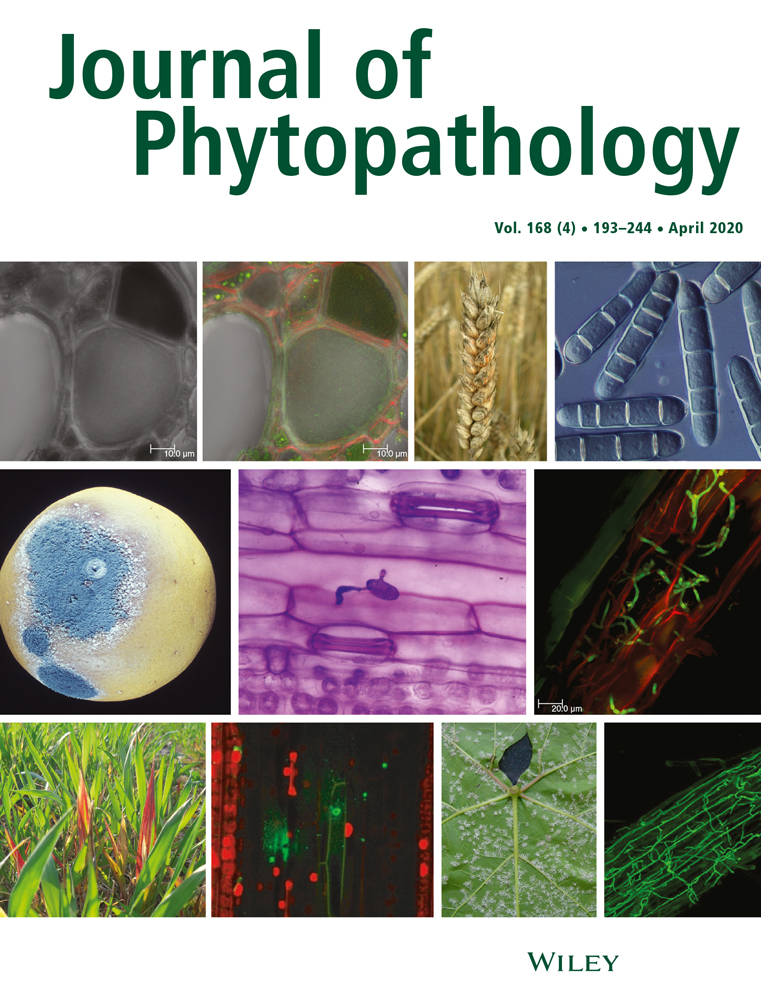Ver ítem
- xmlui.general.dspace_homeCentros e Institutos de InvestigaciónCICVyA. Centro de Investigación en Ciencias Veterinarias y AgronómicasInstituto de BiotecnologíaArtículos científicosxmlui.ArtifactBrowser.ItemViewer.trail
- Inicio
- Centros e Institutos de Investigación
- CICVyA. Centro de Investigación en Ciencias Veterinarias y Agronómicas
- Instituto de Biotecnología
- Artículos científicos
- Ver ítem
Pathotype and SSR variation in Phytophthora sojae from the Argentinean Pampas
Resumen
Genetic variation in Phytophthora sojae was compared between northern (NPS) and southern (SPS) Pampeana sub‐regions, in the core soya bean region of Argentina. Ninety‐three isolates from plants and soil were evaluated in the present study. The pathotype for each isolate was determined using the hypocotyl technique on a set of eight differentials. For neutral genetic diversity evaluation, eight SSRs markers were utilized. Thirty pathotypes were determined,
[ver mas...]
Genetic variation in Phytophthora sojae was compared between northern (NPS) and southern (SPS) Pampeana sub‐regions, in the core soya bean region of Argentina. Ninety‐three isolates from plants and soil were evaluated in the present study. The pathotype for each isolate was determined using the hypocotyl technique on a set of eight differentials. For neutral genetic diversity evaluation, eight SSRs markers were utilized. Thirty pathotypes were determined, including 19 in SPS and 23 in NPS. The number of isolates for each locality and region was unevenly distributed. Pathotype variation was high for P. sojae samples compared among fields and within isolates from single fields. SSR variation studies resulted in an elevated haplotype composition, partitioned at all, but the regional levels. P. sojae populations from Argentina have evolved towards a complex epidemiological scenario, with no evidence of geographic correlation at the pathotypic nor the neutral genetic level. It is likely that future works aiming at elucidating the evolution of pathogenesis in this species will need to include non‐neutral markers, specifically associated to avr loci . The results of the present work are considered a useful contribution to the adequate and sustainable management of this pathogen in the main soya bean area of Argentina.
[Cerrar]

Autor
Grijalba, Pablo Enrique;
Martinez, Maria Carolina;
Guillin, Eduardo Alejandro;
Fuente
Journal of Phytopathology 168 (4) : 228-243 (April 2020)
Fecha
2020-04
Editorial
Wiley
ISSN
0931-1785
1439-0434
1439-0434
Formato
pdf
Tipo de documento
artículo
Palabras Claves
Derechos de acceso
Restringido
 Excepto donde se diga explicitamente, este item se publica bajo la siguiente descripción: Creative Commons Attribution-NonCommercial-ShareAlike 2.5 Unported (CC BY-NC-SA 2.5)
Excepto donde se diga explicitamente, este item se publica bajo la siguiente descripción: Creative Commons Attribution-NonCommercial-ShareAlike 2.5 Unported (CC BY-NC-SA 2.5)

